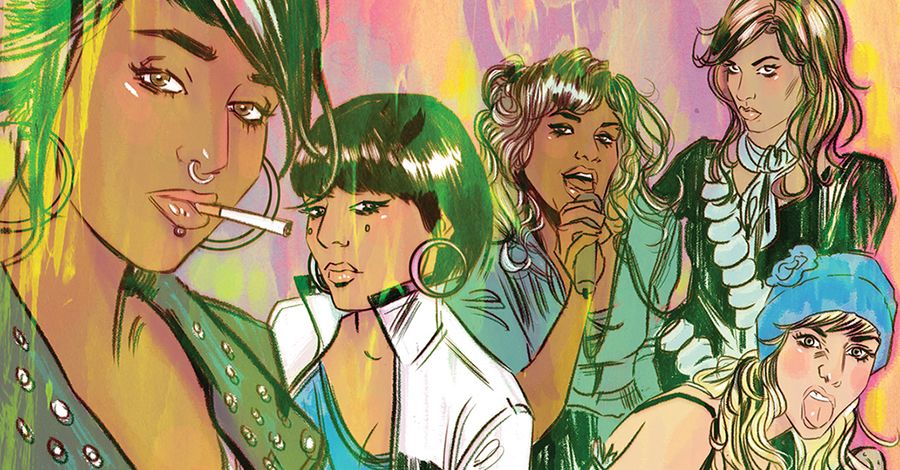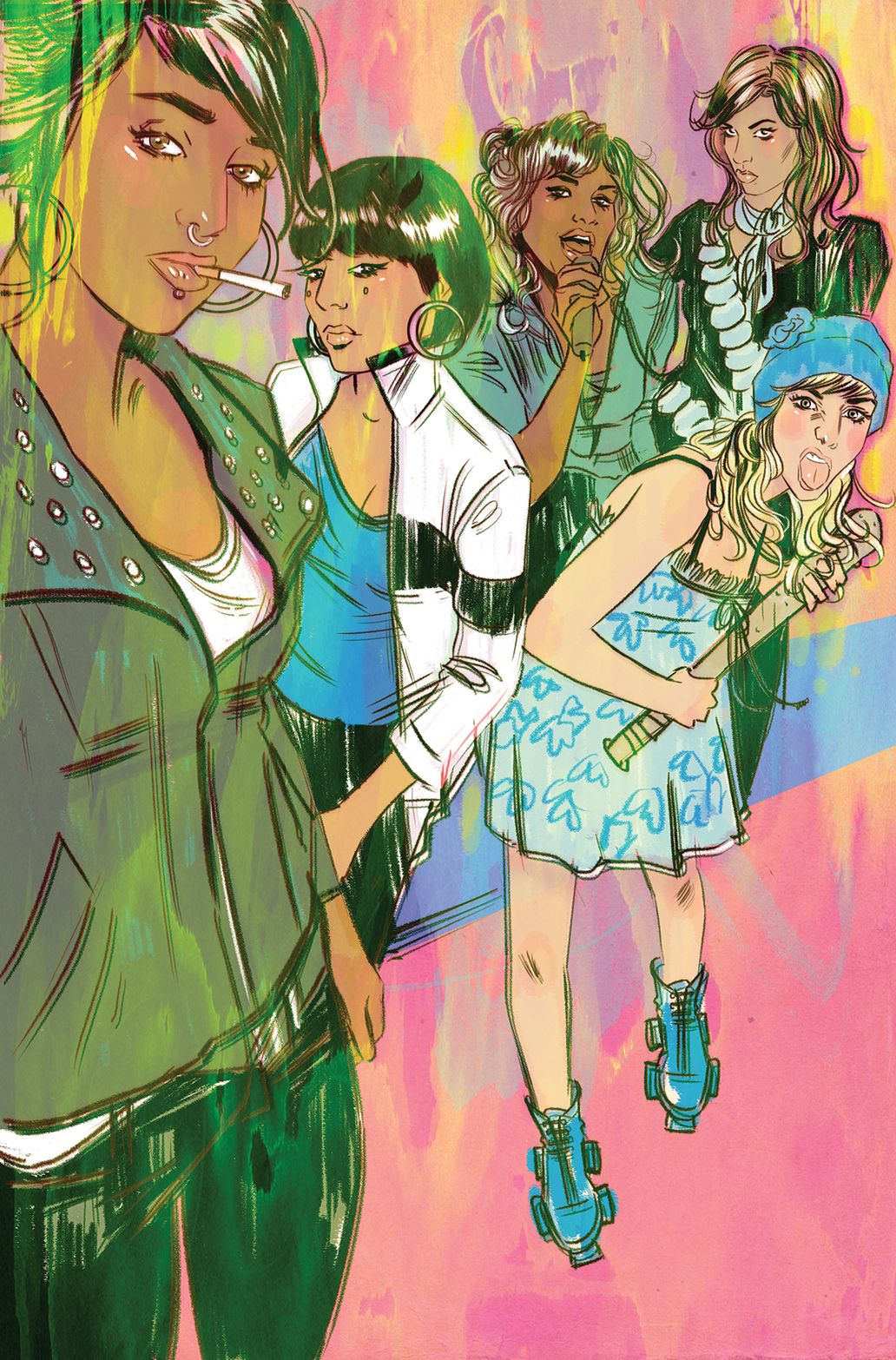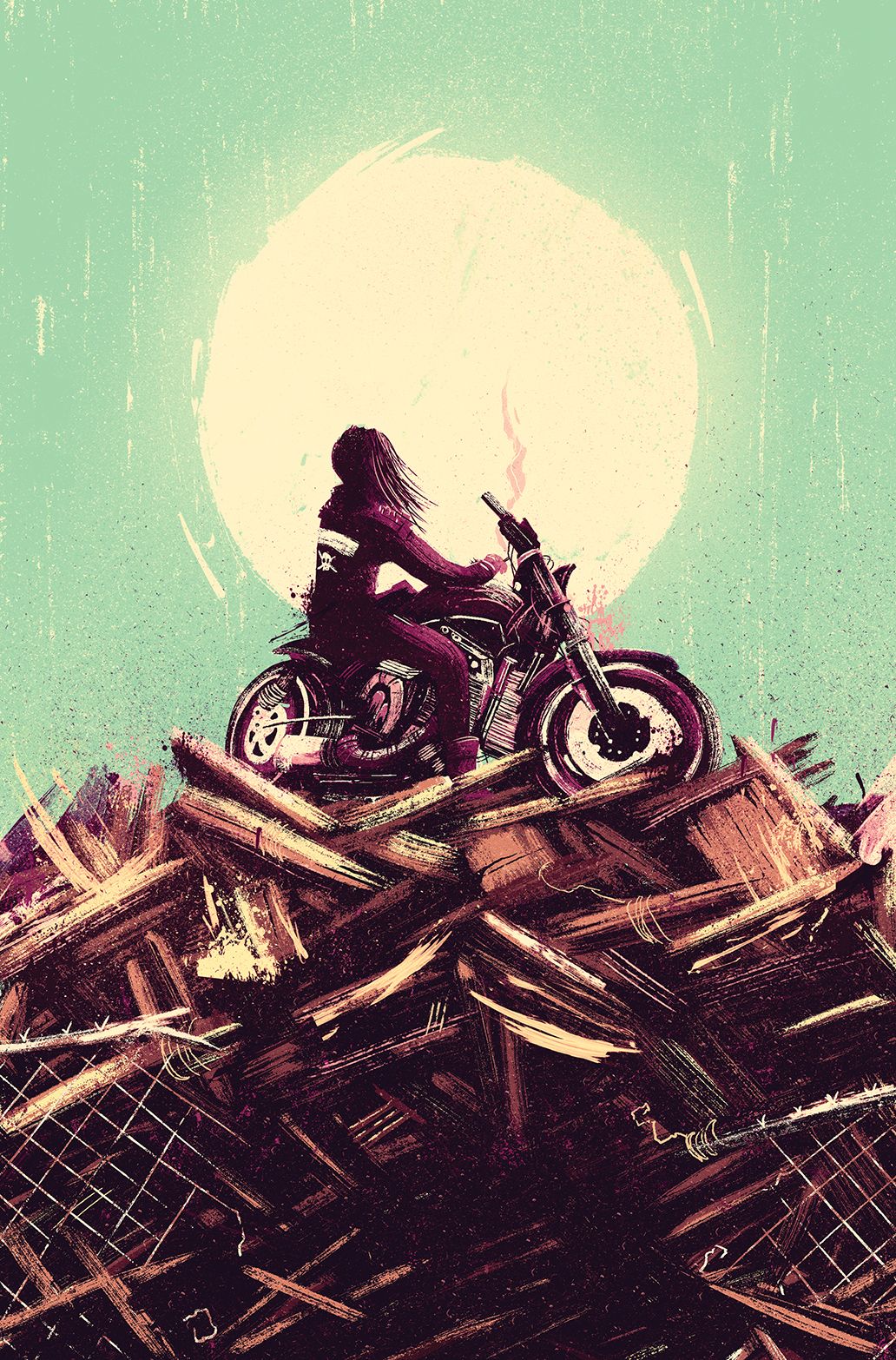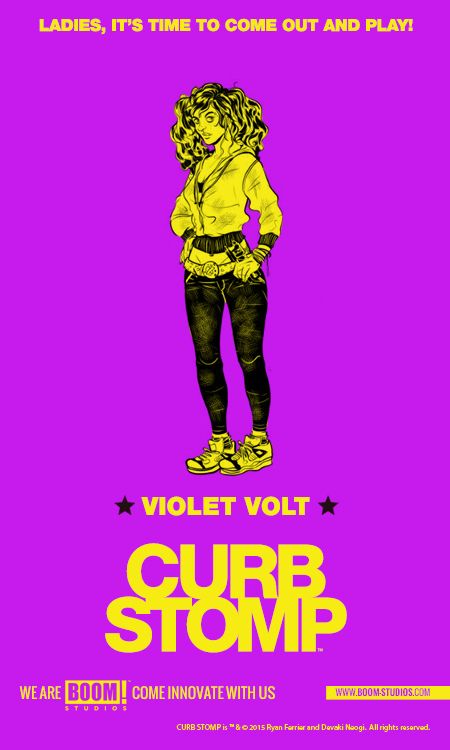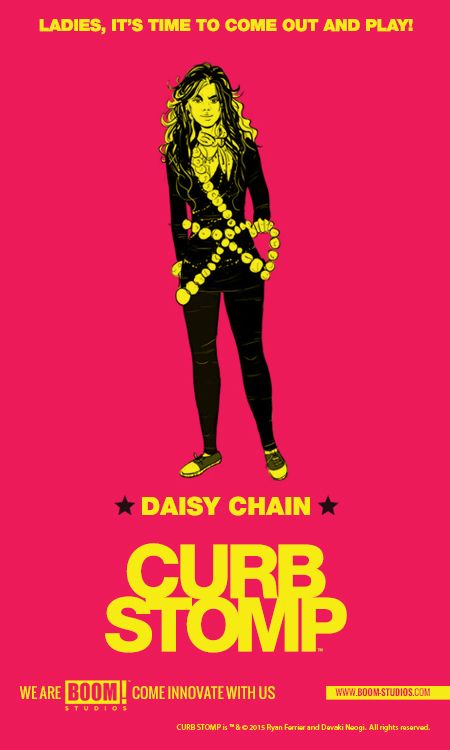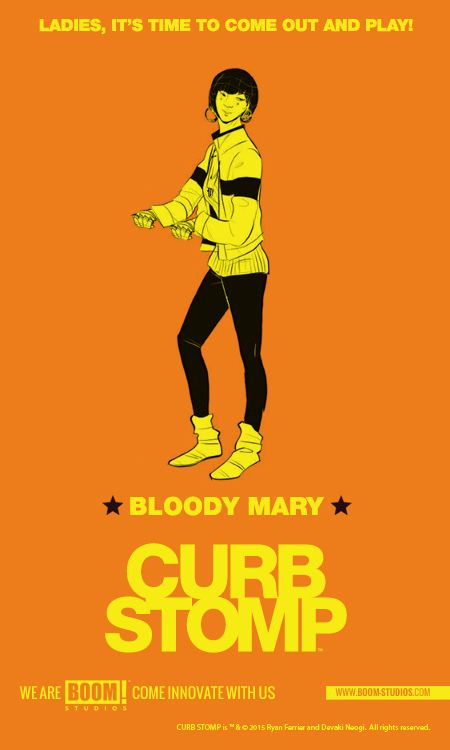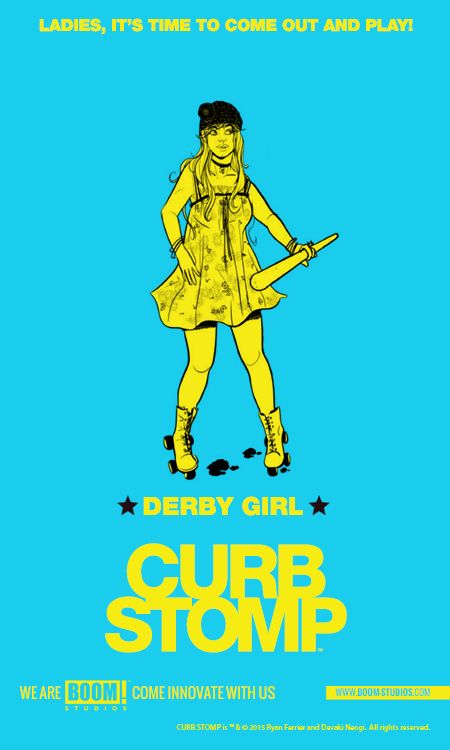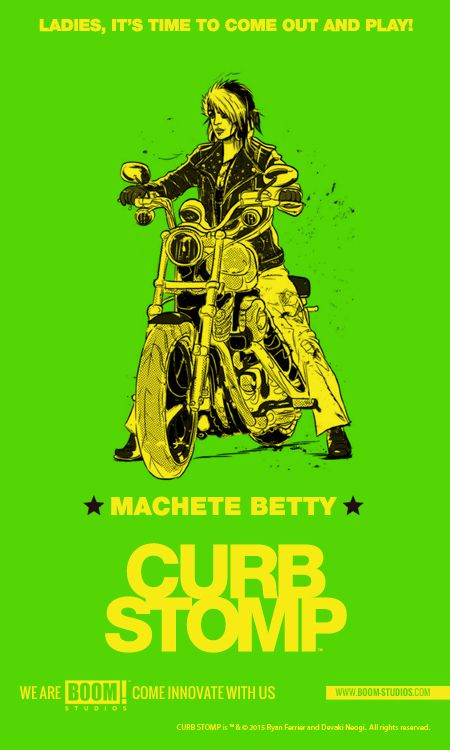Sometimes a girl's gotta do what a girl's gotta do. In Machete Betty's case, that involves helping to defend her hometown of Old Beach against a corrupt local government and two other gangs. Machete Betty and her gang, The Fever, live in a dangerous world teetering on the edge of chaos. One night, after an accidental run-in with a rival gang member, Betty tips the balance leading to all-out war with The Wrath and The Bayside Five. Welcome to the world of "Curb Stomp."
The plot might sound like something out of a movie from the '70s or '80s, but it's coming to a comic shop near you thanks to writer Ryan Ferrier ("Tiger Lawyer"), artist Devaki Neogi ("Zombie Broadway") and BOOM! Studios. "Curb Stomp" is a four issue series launching on February 25 that examines issues of equality, gender and social class while also offering punk rock thrills and action with heart.
CBR News spoke with Ferrier about building this new world from the ground up, working with Neogi and taking charge of a gang of fully-formed characters.
CBR News: The tagline "Four Gangs. Five Girls. No Way Out." hits me with a kind of "Warriors" vibe. Is that something you were going for?
Ryan Ferrier: Devaki and I certainly didn't go into the story with "The Warriors" -- or anything particular -- in mind, but once we got our feet wet, we saw the comparison. It's understandable as "The Warriors" is one of the all-time great gang stories. And I think a lot of what made it so great is inherent with the subject matter. I love the movie, and the book for that matter, but it's also very much it's own thing and that's something we didn't want to encroach on.
"Curb Stomp" is its own beast, and I think they're apples and oranges when you boil it down to the messages and the story we're telling. "The Warriors" is also -- and I may catch some heat for saying this -- wildly dated, and somewhat problematic through today's eyes. But that feeling of being completely outnumbered, against seemingly impossible odds, is something that drives "Curb Stomp," definitely.
Machete Betty might be my favorite comic character name of the year. What makes her the leader of The Fever?
Thank you! We wanted the names of The Fever to be totally memorable and iconic. Machete Betty was actually the first character to really come to life when we started this book. Betty is no doubt the leader of The Fever, but that doesn't mean she's always the strongest or the most wise. She actually sets off a chain reaction that could end up very bad for everyone she knows. Her commitment to her sisters, to her town, is something that never wavers, and her utter fearlessness is what keeps her in the lead. She -- and all of The Fever -- are so completely badass, but they're not just street-punk punching machines. They're all very human and experience a huge array of emotions and challenges.
Ryan Ferrier brings 'Rawr'-der to the Court with "Tiger Lawyer"
"Curb Stomp" takes place in a city of your own making. What benefits did building this world from the ground up give you as a storyteller?
It does, yeah -- basically there is a large, metropolitan city surrounded by three boroughs, each of which has their own gang. The Fever have one of those boroughs. We decided to take the route of not basing this story in an actual city because we're touching on some real issues and messages, ones that affect every city. We wanted the best -- and worst -- of everywhere. This allows us to really make this world our own, and craft it to fit the times and locales that would make these locations their own while making them widely relatable. The world-building has been one of the best parts of creating "Curb Stomp," and Devaki's vision for the settings is totally fantastic.
The inciting incident of "Curb Stomp" involves Machete Betty killing a rival gang member. What kind of repercussions does this have in her world?
As you'll see in issue one, the repercussions of Betty's actions are massive. They're life and death; they could destroy everything and that's what makes "the incident" so crucial to her -- and The Fever's -- life as they know it. But beyond that, it touches on the "rules" of gang warfare -- rather, what happens when those rules no longer apply, and who suffers because of it. Though these gangs may appear to thrive on some form of anti-authority or anarchy, they're still bound by a code. "Curb Stomp" is a prime example of what happens when that code is broken and the mirage of a safety net of society completely and totally fails their own people.
We'll get to the rest of The Fever in a second, but can you tell us a bit about the other two gangs and what Machete Betty's transgression against the rules means to them?
Absolutely, the other gangs in "Curb Stomp" are incredibly important to the story. Though they're not over-the-top (you're not going to see baseball players or roller-mimes in this one), they are each unique in how they handle their business, what their motivations are, and how they interact with the other boroughs. First up is The Wrath, led by King Charles, who serve as the main antagonists for Betty and company. They operate out of Newport, and they're the opposite side of the spectrum from The Fever. They lack hearts, to put it bluntly, and care about two things: power and violence. This makes them incredibly dangerous. Though Betty's "incident" is the inciting spark, it's The Wrath who choose to burn down the rules, the code, and the honor that these gangs once had.
There's also The Bayside Five, led by Nikola, out of Bayside. They're the unpredictable ones, with allegiance only when it serves them. They care more about business, but aren't afraid to get their hands dirty. They're organized and lethal, but cautious. They know the mind-games that come along with the territory. This makes them either very helpful, or exactly the opposite -- all depends on which side you're on and who they feel like standing with.
What can you tell us about the other members of The Fever, like Violet Volt, Derby Girl and the rest?
We're really, really excited for people to meet The Fever. Of all the gangs that control the boroughs, they are the ones you'd be most okay with meeting in the street at night. They're the good ones. They believe in justice and doing the right thing, and protecting what you love, and getting by with an expectation of safety. They love their town more than anything, and they love each other. They're also very unique and different in their own personalities.
Along with Betty, there's Violet Volt, who could be one of my favorite characters to write. She's the youngest of the group and is a total powder keg. She has no filter whatsoever, and very little lack of control, which can sometimes be a bad thing. She's just so super-fun. Derby Girl is another character that plays a huge roll in the story. Derby is fun-loving -- but perhaps in the wrong ways -- and her struggle extends into some personal demons that become realized among the chaos.
Daisy Chain is closest to Betty -- like her right-hand woman -- and the two share a very close bond. She's dangerous as hell, but also the heart of the group. And lastly is Bloody Mary, who is definitely the one you'd least want to get on the wrong side of. Mary is interesting in that she has very specific aspirations and won't let anything get in her way. She will kill you if she has too.
What unites The Fever as a group aside from location?
First and foremost is family. Although most of them aren't blood related, the borough of Old Beach -- where The Fever are located -- prides itself on its community. That's why they do what they do: they love everyone, they love each other and they take care of one another. Beyond that, they've all gone through similar struggles. This isn't a wealthy town, and everyone has endured hardship, social injustices and felt the blowback of a very broken system. They unite because they want to, but also because they have to. It doesn't hurt that The Fever themselves are really rad punk women with a taste for kicking ass if they have to and ripping the night up because they want to.
One aspect of the story we haven't really talked about yet is that of the government or police. With a corrupt leader in place, is there any real hope of help from that angle?
It certainly seems that way, and it plays a huge, huge part of the story. We realize very early on that The Fever is fighting to save a system that is massively broken to begin with, so what are they fighting for if they manage to stay alive? One character that readers will meet in issue one is the culmination of that broken system, a man with a terrifying amount of power who wants to capitalize on the warfare between boroughs. For The Fever -- and all of Old Beach -- it's absolutely overwhelming. None of them are going down without a fight, however.
The story and artwork both have a very strong punk feeling to them. What aspects of the movement or aesthetic were important to bring through in "Curb Stomp?"
Definitely a lot of punk feels in the book. It's something that I've been close with a fair amount of my life. I grew up an outsider, and I still consider myself so. And that's great! There's a moment in your life when you flip a switch and realize that being an outsider is good and I think that speaks volumes of what "punk" is. I think it's important that The Fever do what they have to do for themselves and they don't care who or what gets in their faces. We should all do that. I think we should all question authority at every turn, and I think we should never, ever back down from anything, while upholding our morals and doing what we know is right. I also think it's really important that Violet Volt puts on her red lipstick, kisses her baseball bat and then bashes out a dudes teeth with it. Because fuck 'em.
When I talked to Noelle Stevenson and Grace Ellis about "Lumberjanes," they mentioned that one way to help make a more diverse group of female characters is to bring in as many women as possible and let them express themselves. Was that an idea you played with here?
There was never a "template" for "Curb Stomp" that Devaki and I created and upheld when we started, honestly. Creating the cast of "Curb Stomp" was very natural, and it spoke directly to the issues and messages we want to tackle -- at the same time, The Fever are all women for a reason, and it's not something we take lightly or throw around for the sake of it. I do think, however, that diversity -- both in gender, identification, race, class and so forth -- is absolutely important. It's vital. I believe we need to do more as creators to represent and to reach people that fit outside the straight-white-dude audience.
Stevenson & Ellis Camp Out With "Lumberjanes," Battle "No Girls Allowed" Attitude
For me personally, as a writer, I felt bored with starting a new project with "Dude X meets Dude Y and then adventures!" To me, that's just boring and lazy and we're programmed to consume it to a point where that's what we're creating. I wanted to smash that template in my head, and I want more people to read this comic and relate to it. To connect with it. I love comics more than anything in the world. Anything. And it still breaks my heart to go into a comic shop and see "Dudes Punching Dudes: The New Dude Punchenings #342" on every shelf. There is so, so much representation, human representation, that is overlooked in comics -- and to be fair, most mediums -- and it's a shame.
Joe Keatinge's said it many times, both with "Glory" and "Shutter" -- both wonderful books and I hope he doesn't mind me paraphrasing him: it's a shame that this is still a discussion at all, and I can't wait for a time when it's not unusual to have books led by women or people of color. But looping back around to the start, making The Fever women is imperative to the story, and is something that Devaki and I -- and our amazing editorial team -- are incredibly sensitive to and also very proud of. I also think that writing men is something I'm less experienced with. Male characters, sure, but I have more of a propensity for robots and talking animals and badass punk women.
How did you come to work with Devaki Neogi?
Devaki is so freaking amazing and I really think people's lids are going to flip when they see her work and Neil Lalonde's colors, which, by the way, are gorgeous. I remember seeing Devaki's work a couple of years ago when she did some work for "Mumbai Confidential" from Archaia. I saw one page and was totally blown away. We connected on Twitter, I believe, and I was able to check out more of her work, and I knew I had to see if she was interested in this story. Thankfully, she was, and we've been able to really collaborate and build these characters from the ground up. Devaki has an immaculate attention to detail and style, and her inks are so expressive and elegant -- but she also completely captures the grittiness and violence of the Curb Stomp world in a way that's pretty tough to describe. We can't wait for everyone to see it.
It sounds like you and Devaki worked really well together to create this world. How much of "Curb Stomp" did you have plotted out or written before you started collaborating?
Working with Devaki has been an absolute pleasure. She and I joined forces very early in the concept stage. I had the skeleton of the story mapped out in my head, and as we talked back and forth and she began putting visual concepts out there, her work in turn informed the story. There's obviously been some changes to the story as we both worked more in the world. We definitely understand each others' strengths and weakness and aim to challenge both. Working with BOOM! has also been an amazing experience. Our editors Eric [Harburn] and Jasmine [Amiri] are both brilliant and they bring out the best in everyone, and just raise the work to the next level.
To see those next level results, check out "Curb Stomp" #1 on Feb. 25 from Ryan Ferrier, Devaki Neogi and BOOM! Studios.

